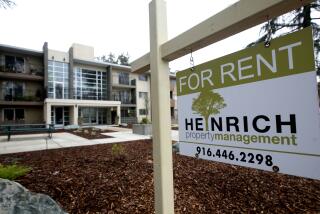A walk-through at move-in time paves the way for a clean exit
- Share via
Question: I’m moving into a new place that requires a large security deposit. How do I protect myself so I can be certain to get it back when I move out?
Answer: Bitter battles are fought between landlords and tenants over security deposits.
How to avoid conflict? Start with the move-in, being sure to do a complete walk-through of the premises. Most leases decree that the unit “is to be returned in the same condition as when first rented, less wear and tear.” Your task at hand is to establish exactly what condition the place was in from the start.
A helpful landlord will provide a walk-through or inventory checklist at move-in. If you don’t get one, create your own, taking a page from a car rental form.
For cars, a complete “walk around” is conducted with a diagram of the vehicle to label and describe any damage. For a residential rental, draw a basic floor plan on a sheet of paper. Label the rooms, and indicate where windows and doors are placed to help narrow down the details. Since a residential rental is more complicated than a car, bring a camera to back up any notable items. For each room, jot done the following basics:
* The paint and how it looks. If the unit was freshly painted, top to bottom, that’s the threshold you’ll be responsible for. Be sure to look all around when checking the condition of the paint for each room.
* Floors. Every type has its weak spots. For example, wood floors can be easily scratched, and expensive to refinish. Ask when the floors were last refinished or replaced. If freshly refinished, ask what steps are needed to keep them in good condition. Carpets may look fine, but knowing their age helps.
Vinyl or linoleum underfoot? Flooring seams are notorious for splitting, especially where water can seep in around sinks and bathtubs. Check for any pull-ups or binding, or the pulled-up vinyl could be on your tab.
* Window coverings should be checked. Even though most jurisdictions don’t require window coverings, such as blinds or drapes, many landlords include them at move-in. If none exist or only on certain windows, jot it down on your floor plan.
Don’t overlook the screens. Although they’re not terribly expensive, replacing several can add up. While you’re looking out the windows, be sure that the glass isn’t cracked or broken, and that all windows open, close and lock properly. If not, let the landlord know.
* Check light fixtures. A flip of a switch will determine whether fixtures work as they should. Ask whether there are any master switches, typically found in living rooms that control an outlet or two, to save frustration later.
* Smoke detectors must be centrally located outside each sleeping area. Generally, each bedroom is provided a smoke detector, with another detector down any hall exceeding six feet beyond the bedroom door. Make sure alarms are fully functional by pressing the test button, usually at the center of the detector. If the alarm sounds the alert, you’re OK; otherwise, ask the landlord to replace it.
* Drains. Run the water a few minutes in sinks and showers. If water doesn’t drain freely, add that to your repair request list.
* Kitchen. With appliances, there’s much to explore. Open the oven. Is it spotlessly clean or caked with grease? Do all the stove burners fire? Does the garbage disposal hum when switched on, or simply groan with trapped debris? If a refrigerator is included, open the door and take a sniff inside.
* Bathroom. Built-ins, such as soap dishes and towel racks, should be in top shape. Be sure that the tub/shower enclosure is clean and not hiding mold in the cracks, or that water isn’t dripping from the spout. Check that the toilet is clean, and that the sink is not cracked or chipped.
How is the tile? Tile is expensive to replace, especially in older buildings where the classics are no longer available. One chipped corner tile can cost several hundred dollars to replace.
* Jot down how many keys you are given at move-in, including the mailbox key. The number of remote controls or security type keys should be noted too.
Doing a good job of keeping track of the details from the start can save you time, frustration and your security deposit at move-out time.
Reader comments may be sent to hmayspitz@aol.com.
More to Read
Inside the business of entertainment
The Wide Shot brings you news, analysis and insights on everything from streaming wars to production — and what it all means for the future.
You may occasionally receive promotional content from the Los Angeles Times.










